4.1: Drawing
- Page ID
- 156866
Overview
This chapter introduces drawing, a process that is not only basic to art but also a fundamental part of human communication. Learning to draw is the first step in developing the skill to write the letters of the alphabet, but drawing can also provide a rich array of communicative expressions. Drawing media comprise two main categories, dry and wet. Each possesses its own unique and versatile properties.
- Drawing is the simplest and most efficient way to communicate visual ideas, and for centuries charcoal, chalk, graphite and paper have been adequate enough tools to launch some of the most profound images in art.
- Leonardo da Vinci’s The Virgin and Child with Saint Anne and Saint John the Baptist wraps all four figures together in what is essentially an extended family portrait.
- Da Vinci draws the figures in a spectacularly realistic style, one that emphasizes individual identities and surrounds the figures in a grand, unfinished landscape. He animates the scene with the Christ child pulling himself forward, trying to release himself from Mary’s grasp to get closer to a young John the Baptist on the right, who himself is turning toward the Christ child with a look of curious interest in his younger cousin.
- The traditional role of drawing was to make sketches for larger compositions to be manifest as paintings, sculpture or even architecture. Because of its relative immediacy, this function for drawing continues today.
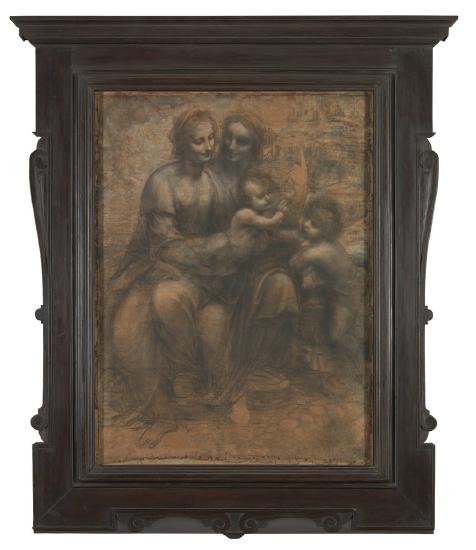
Leonardo da Vinci, Madonna and Child with St Anne and the Young St John, 1507-08, Charcoal with white chalk heightening on paper, 141,5 x 106 cm, National Gallery, London Types of Drawing Media. Purchased with a special grant and contributions from the Art Fund, The Pilgrim Trust, and through a public appeal organized by the Art Fund, 1962 Object Number: NG6337
Dry Media
- Dry Media includes charcoal, graphite, chalks, and pastels.
- Each of these mediums gives the artist a wide range of mark-making capabilities and effects, from thin lines to large areas of color and tone.
- The artist can manipulate a drawing to achieve desired effects in many ways, including exerting different pressures on the medium against the drawing’s surface, or by erasure, blotting, or rubbing.
Graphite
- Graphite media includes pencils, powder, or compressed sticks.
- Each one creates a range of values depending on the hardness or softness inherent in the material. Hard graphite tones range from light to dark gray, while softer graphite allows a range from light gray to nearly black.
- Gedö's use of varied pencil pressure suggests texture and creates emphasis
- Graphite is handled more softly in the areas representing the skin
- Gedö was a Holocaust survivor; this drawing records her gaunt features shortly after her internment2

Ilka Gedö, Self-portrait, 1944. Graphite on paper, 11⅝ × 8⅜". British Museum, London, England. Licensed by Gateways to Art: Understanding the Visual Arts, Third Edition. Copyright © 2015 Thames & Hudson
Charcoal
Charcoal is made from wood or other organic material that has been burned in the absence of oxygen. This process leaves a relatively pure black carbon powder. Artists compress this dry powder, or pigment, with a binder, a sticky substance like pine resin or glue made from the collagen of animal hides, to make hand-held charcoal blocks of various strengths and degrees of hardness. This compressed charcoal is used to make very dark marks, usually on paper. Compressed charcoal is challenging to erase.

Figure 2.2 | Edmond Aman-Jean
- Charcoal also comes in a form called willow or vine charcoal. This form of drawing charcoal leaves a very light mark as it is simply burned twigs. It is generally used for impermanent sketches because it does not readily stick to paper or canvas and is easily erased. Both compressed and vine charcoal drawings are easily smudged and should be protected by a fixative that adheres the charcoal to the drawing surface and creates a barrier resistant to smudging
- Charcoal, perhaps the oldest form of drawing media, is made by simply charring wooden sticks or small branches, called vine charcoal, but is also available in a mechanically compressed form.
- Vine charcoal comes in three densities: soft, medium, and hard, each one handling a little differently than the other.
- Soft charcoals give a more velvety feel to a drawing.
- The artist doesn’t have to apply as much pressure to the stick in order to get a solid mark. Hard vine charcoal offers more control but generally doesn’t give the darkest tones. Compressed charcoals give deeper blacks than vine charcoal, but are more difficult to manipulate once they are applied to paper.
- Charcoal smudges easily, usually has strong dark value, and is soft, creating lines that can be easily shaped
- In Käthe Kollwitz, Self-portrait, the face and hand are rendered realistically. In contrast, she uses a spontaneous burst of charcoal marks to draw the arm. We see the nervous energy connecting eye to hand 2
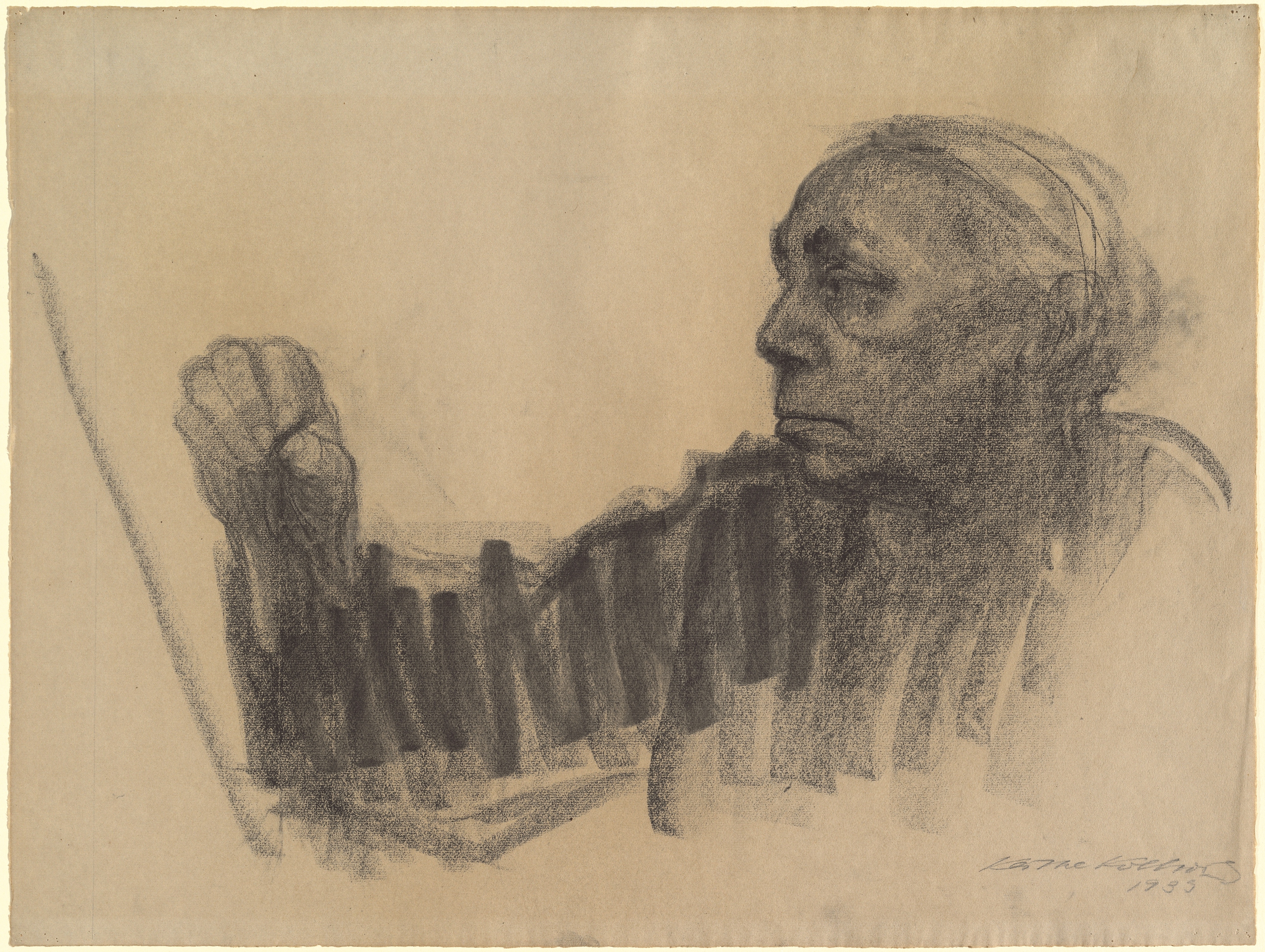
Käthe Kollwitz, Self-portrait in Profile to Left, 1933. Charcoal on paper, 18¾ × 25". National Gallery of Art, Washington, D.C. Licensed by Gateways to Art: Understanding the Visual Arts, Third Edition. Copyright © 2015 Thames & Hudson
Pastels
- Pastels are similar to compressed charcoal but, instead of finely powdered carbon, finely ground colored pigment and a binder are used to create handheld colored blocks. (Figure 2.4) The powdery pigments smudge easily, so the image created must be displayed under glass or covered with a fixative. Edgar Degas (1834-1917, France) is famous for the subtle yet distinct layering of color he was able achieve in his pastel drawings. (Figure 2.5)

- Pastels are essentially colored chalks usually compressed into stick form for better handling. They are characterized by soft, subtle changes in tone or color. Pastel pigments allow for a resonant quality that is more difficult to obtain with graphite or charcoal. Picasso’s Portrait of the Artist’s Mother from 1896 emphasizes these qualities.

Picasso, Portrait of the Artists's Mother, Portrait de la mère de l'artiste, 1896, Pastel on paper. Public domain.
Wet Media
Ink
- Wet drawing media traditionally refers to ink but really includes any substance that can be put into solution and applied to a drawing’s surface.
- Because wet media is manipulated much like paint – through thinning and the use of a brush – it blurs the line between drawing and painting.
- Ink can be applied with a stick for linear effects and by brush to cover large areas with tone. It can also be diluted with water to create values of gray. The Return of the Prodigal Son by Rembrandt shows an expressive use of brown ink in both the line qualities and the larger brushed areas that create the illusion of light and shade.
Felt Tip Pens
- Felt tip pens are considered a form of wet media.
- The ink is saturated into felt strips inside the pen then released onto the paper or other support through the tip.
- The ink quickly dries, leaving a permanent mark.
- Traditional Chinese painting uses water-based inks and pigments. In fact, it is one of the oldest continuous artistic traditions in the world. Painted on supports of paper or silk, the subject matter includes landscapes, animals, figures and calligraphy, an art form that uses letters and script in fluid, lyrical gestures.
- Two examples of traditional Chinese painting are seen below.
- The first, a wall scroll painted by Ma Lin in 1246, demonstrates how adept the artist is in using ink in an expressive form to denote figures, robes and landscape elements, especially the strong, gnarled forms of the pine trees. There is sensitivity and boldness in the work.
- The second example is the opening detail of a copy of “Preface to the Poems Composed at the Orchid Pavilion” made before the thirteenth century. Using ink and brush, the artist makes language into art through the sure, gestural strokes and marks of the characters.
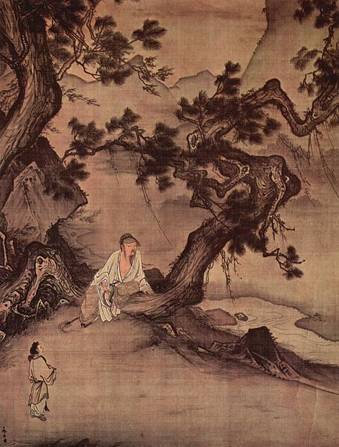
Ma Lin, Wall Scroll, ink on silk. 1246 Used under GNU Free Documentation License
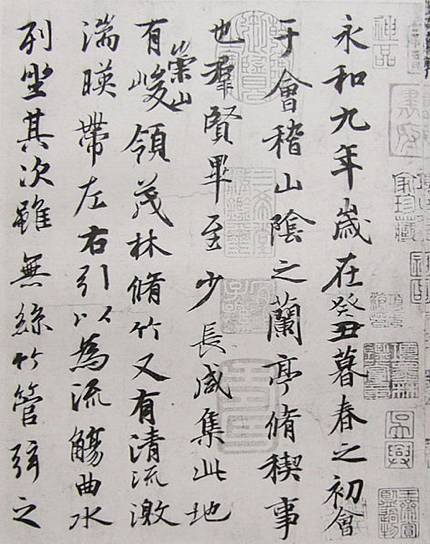
Opening detail of a copy of Preface to the Poems Composed at the Orchid Pavilion. Before the thirteenth century. Hand scroll, ink on paper. The Palace Museum, Beijing. Licensed through Creative Commons.
Alternative Ways of Using Drawing
- Drawing is a foundation for other two and three-dimensional works of art, even being incorporated with digital media that expands the idea of its formal expression.
- The art of Matthew Ritchie starts with small abstract drawings.
- He digitally scans and projects them to large scales, taking up entire walls. Ritchie also uses the scans to produce large, thin three-dimensional templates to create sculptures out of the original drawings.
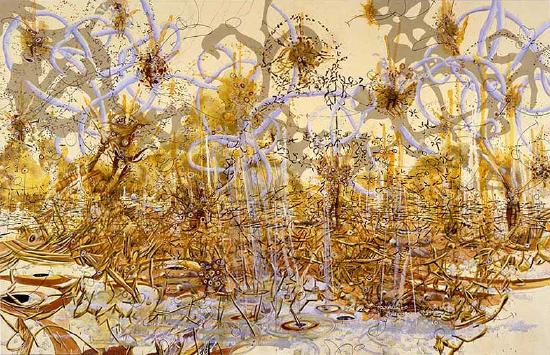
Matthew Ritchie (American, born 1964). No Sign of the World, 2004. Oil and marker on canvas, 99 x 154 in. (251.5 x 391.2 cm). Brooklyn Museum, Gift of Jacqueline and Mortimer Sackler, 2015.101. © artist or artist's estate (Photo: image courtesy of Art21, CUR.2015.101_Art21_photograph.jpg)
Erasers and Fixatives
![]()
Robert Rauschenberg, Erased de Kooning Drawing, 1953Erased de Kooning Drawing. © Robert Rauschenberg Foundation licensed by San Francisco Museum of Modern Art
- Erasers can be used to create light marks and highlights in areas already drawn
- Fixative is a coating that preserves the appearance of a drawing by making the dry medium adhere to the surface of the paper
- Rauschenberg created a new work of art by erasing a drawing by the famous artist Willem de Kooning
- The drawing was made with charcoal, oil paint, pencil, and crayon; it took nearly a month to erase 2,3
- More information here https://www.sfmoma.org/artwork/98.298/ (Links to an external site.)
Sources
- Beth Harris and Steven Zucker, "Leonardo, The Virgin and Child with St. Anne and St. John the Baptist (Burlington House Cartoon)," in Smarthistory, November 18, 2015, accessed April 5, 2022, https://smarthistory.org/leonardo-virgin-and-child-st-anne-st-john-the-baptist-cartoon/.
- DeWitte, Debra J., Larmann, Ralph M.,and Shields, M. Kathryn. Gateways to Art: Understanding the Visual Arts, Third Edition. 2018
- Delmar Larsen. Developed by Wendy Riley from Columbia Basin College with contributing work from Lumen Learning. https://human.libretexts.org/Bookshe...iation_(Lumen)
 This work is licensed under a Creative Commons Attribution 3.0 License.
This work is licensed under a Creative Commons Attribution 3.0 License. - Pamela Sachant, Peggy Blood, Jeffery LeMieux, & Rita TekippeUniversity System of Georgia via GALILEO Open Learning Material

